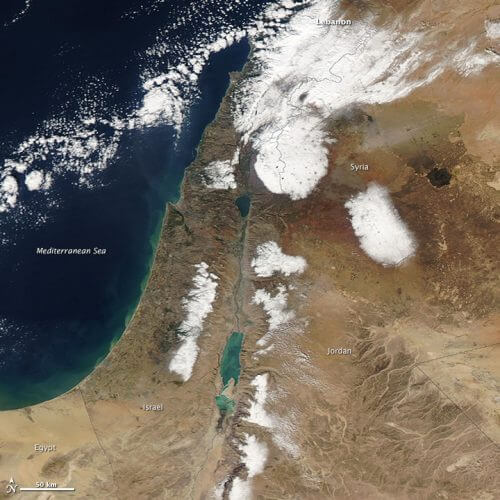Researchers from the Weizmann Institute have deciphered the mechanisms that push the rain storms north and south with global warming

Anyone who gets on Route 6 in the Beer Sheva area and drives north, will pass through three climate zones in less than an hour. To notice this, you don't need to be a paranoid forecaster: it's enough to look out the window and see the route of the vegetation and the landscape. The State of Israel stretches in total between the lines of latitude 290 (Eilat) and 330 (Kiryat Shmona) - but its location on the seam between the desert strip and the temperate climate area gives it a diverse climate - but also a special sensitivity to climate changes. Sophisticated climate change models predict that the areas of storms and rain will be shifted towards the poles due to global warming. In local terms you can say that the climate of Mitzpe Ramon will migrate to Beer Sheva, the climate of Beer Sheva will move to Tel Aviv, and so on. And this is not just a forecast: this trend has actually been observed in recent decades.
In an article published this week in the scientific journal Nature Geoscience Scientists from the Weizmann Institute have shown that the shifting of the climate zones is largely due to the increased movement of the rain storms towards the poles. These findings were made possible due to deciphering the physical mechanisms that are responsible for the movement of the storms through a unique approach - adopting the point of view of the storm itself.
Rainstorms - those familiar "barometric depressions" from the weather forecast - move around the world in preferred tracks, called "storm tracks". For those who have wondered, for example, why the British often talk about the weather, then the answer is that it is no coincidence: gray London is deep in the eye (track) of the storm, and therefore - winter or summer - it is not recommended to leave the house without an umbrella. Storm tracks do not coincide with latitudes: Regardless of global warming, storms move on average from west to east, with a slight tilt toward the north (or south in the southern hemisphere). Therefore, a storm that forms in the sea near the coast of America in latitude 400 will reach Europe in the area of latitude 500; This is also the reason why North America is colder than the corresponding regions in Europe. However, until recently it was not known what the physical mechanisms are that generate this tendency to the north. Dr. Talia Tamarin, from Prof. Yohai Caspi's group in the Department of Earth and Planetary Sciences, solved this riddle as part of her doctoral thesis - by adopting a Lagrangian point of view (named after Joseph-Louis Lagrange, the Italian mathematician of the 18th century -XNUMX).
"For those who have wondered, for example, why the British often talk about the weather, then the answer is that it is no coincidence: gray London is deep in the eye (track) of the storm, and therefore - winter or summer - it is not recommended to leave the house without an umbrella"
What is a Grangian approach and how is it different from the corresponding dynamical perspective? A man is driving on a highway when a storm is raging above him. The vehicle he is driving and the storm are moving in the same direction and at the same speed, so the storm continues to rain on him the entire journey. While driving, the driver passes people standing on the side of the road: while he is racing with the wind - the storm passes over them, rains its precipitation and continues on. The driver's perspective is Lagrangian – the perspective of the storm itself, while the perspectives of the people along the road are Eulerian (named after Leonard Euler, the 18th century Swiss mathematician). The Eulerian point of view is more accepted in the study of climate, because it allows to produce statistics of long periods of time. In contrast, the Lagrangian point of view is individual regarding each and every storm, and requires a complicated tracking of the changing dynamics of each storm in time and space.

To explain the tendency of the storms towards the poles, Dr. Tamarin built a mathematical model that combines the two points of view, and solves the flow equations in the atmosphere; These calculations, carried out in a parallel computer system, take several days. Prof. Caspi explains: "There were several approaches to examining the tracks of the storm; For example, using full climate models. But from these models it is difficult to deduce cause and effect: you see a final situation - where there are more storms and where there are fewer storms - but it is difficult to conclude why and how they develop in time and space. On the other hand, you can look at individual storms and analyze them, but this is a chaotic and noisy system, and there is a strong dependence on the initial conditions - since no storm is like the previous one. Talia studied an abstract flow model, connected to it an algorithm that tracks the storms, and performed a mathematical analysis that made it possible to understand the physical processes that control the paths of the storms. The abstract model makes it possible to create averages of thousands of storms, thus eliminating the dependence on the initial conditions. The uniqueness of the method developed by Talia is that it allows us both to qualitatively understand the physical mechanisms that control the movement of storms towards the poles, and also to quantitatively assess the expected changes in storm tracks due to global warming.'
In the current study, Dr. Tamarin went a step further, and integrated her findings into complex models of climate change. This is how she discovered that, apart from a shift in the location of the formation of the storms expected due to global warming, the dynamics of the storms themselves towards the north will become stronger due to the intensification of the two processes affecting it. One process is related to the vertical structure of the winds: a necessary condition for the intensification of the cyclonic rainstorm is a certain occurrence of currents in the upper part. In her previous study, Dr. Tamarin maintained that these currents in Brom push the storm toward the poles. In other words, the structure that allows the storm to grow is also the one that inevitably diverts it north. With global warming it is expected that these currents will be stronger, as will the diversion. The second process is related to moisture and capsule heat release. "Since cyclones rotate counterclockwise, east of their center there is air moving north, which is warmer and more humid," explains Dr. Tamarin. "This process attracts them towards the northeast. With global warming, the air will contain more moisture, so the attraction will be stronger."
In the video: simulation of the concentration of water vapor in the Earth's atmosphere. Source: NCAR
The climate change models predict a shift of two degrees (latitude) for every four degrees (warmth) increase in global temperature (a scenario that could last as long as 100 years). The dynamics of the storms described in the study are responsible for an average shift of one degree, while the shift in the location of the formation of the storms is responsible for another degree. But two degrees of latitude in 100 years is seemingly a minor shift. Prof. Caspi explains: "It is true that a degree or two sounds a bit much, but when it comes to the average climate for a latitude, even a change of a tenth of a degree may be dramatic. As you remember, all of Israel is four degrees. And if, for example, the climate of Dimona moves to Be'er Sheva, it is very significant."
See more on the subject on the science website:

7 תגובות
justice miracles,
The numbers indicated in the article indicate tenths of degrees and not degrees.
In degrees the latitudes are: Eilat = 29, and Kiryat Shmona = 33.
to Luz
Latitudes are measured in units called degrees, just like the division into degrees in a circle in plane engineering.
From the equator to the pole (north/south) there are 90 lines of latitude numbered from 0 at the equator to 90 at the poles. The latitudes 90-north and 90-south are points that indicate the poles respectively. The distance between every two consecutive lines of latitude is about 111 km.
jubilee
Green vegetation, and not necessarily trees, helps the absorption of PADH. Reducing human emissions of PAD will certainly significantly reduce the rate of increase in the concentration of PAD in the atmosphere.
Think about a seat belt in a car, or about vaccines. They do not eliminate the dangers, but it should be a complete shame not to use these means.
Luz
According to the numbers of Eilat and Kiryat Shmona, the units are ten times higher.
In what units does the article measure latitude?
The question is whether planting trees that will absorb the solar radiation and reducing the activity of power plants operating with fuel/gas/coal, can reduce or reverse the process